#GC2022 is accepting submissions - 25d 27h 05m 44s
The architectural heritage of Shanghai, strongly influenced by its colonial history, is currently suffering from the urban redevelopment of the city. The "Lilong", intense and socially connected communities, are being replaced by tons of concrete due to a massive 'tower invasion'. These alien buildings are scraping away these urban villages destroying communities and relocating the inhabitants in the suburbs. The complexity of the urban development of Shanghai and the place of the urban heritage in this process is firstly analyzed. Strategies regarding the possibilities to develop the city while preserving the urban heritage are discussed considering Shanghai as a city for experimentations.. The essay is introducing an urban strategy regarding to the preservation of existing urban fabric through a multi historical centre. District are developed allowing smaller economy to develop necessary for the integration of new rural migrants. Urban Growth is orchestrated in relation with its past, renewing the identity of the Chinese city.
 Overview of Shanghai city. Image © Greg Girard
Overview of Shanghai city. Image © Greg Girard
Introduction
Shanghai has always distinguished itself from Chinese mainland cities. It was founded in 1000 AD and inhabited by fisherman benefiting from the Huangpu River. Located on the Yangtze River delta, Shanghai has always been a commercial city. Since opening the harbor to Western countries, it became one of the most important harbors in the world. Today, its central location on the East coast of China enables connection with distant provinces, coastal regions and large cities through an important road, rail and river network.
Currently, 23 million people live in Shanghai, with a density of 43,000 inhabitants / km² in the inner core (Huangpu Qu, Jing'an Qu, and Luwan Qu districts) which is almost twice more than the density of Manhattan. Over the last 20 years, Shanghai has been the target of a large urban redevelopment program. Facing a significant population growth, the municipality promoted vertical expansion to solve overcrowding. As a result, Shanghai's current urban landscape is characterized by international influences and the desires for modernization.
During my 16 months stay in China, I observed the landscape of Shanghai and was seized by the contrast between rapidly rising buildings and the old urban fabric. A strong visual tension could be felt between heterogeneous buildings. I witnessed traditional lanes, called "Lilong" – forming intense and socially connected communities - suffering from a massive "tower invasion". These alien buildings are scraping away urban villages and destroying communities, forcing long-time inhabitants to relocate to the suburbs. The slogan of the Communist Revolution remains often a reference for current politics.
"Without destroying, we do not build; with the word destroy in mind, we are building already"
- Mao Zedong
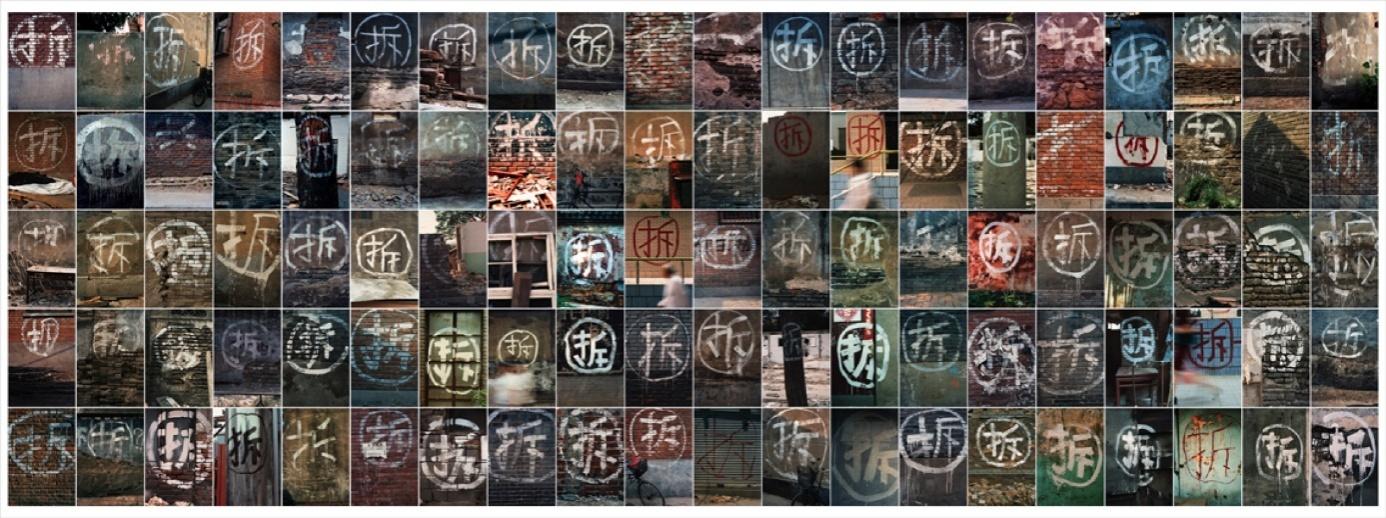
«Table of hundred chai» is work of the artist Wang Jinsong. Today, when we walk in those small streets, we can often see the sign «chai» written on the wall, which means «destruction». Here the artist shows photos of hundred «chai» characters, suggesting the inescapable reality of urban redevelopment. image © Alors, la Chine ? , éditions Centre Pompidou, Paris
The aims of this article are two folds:
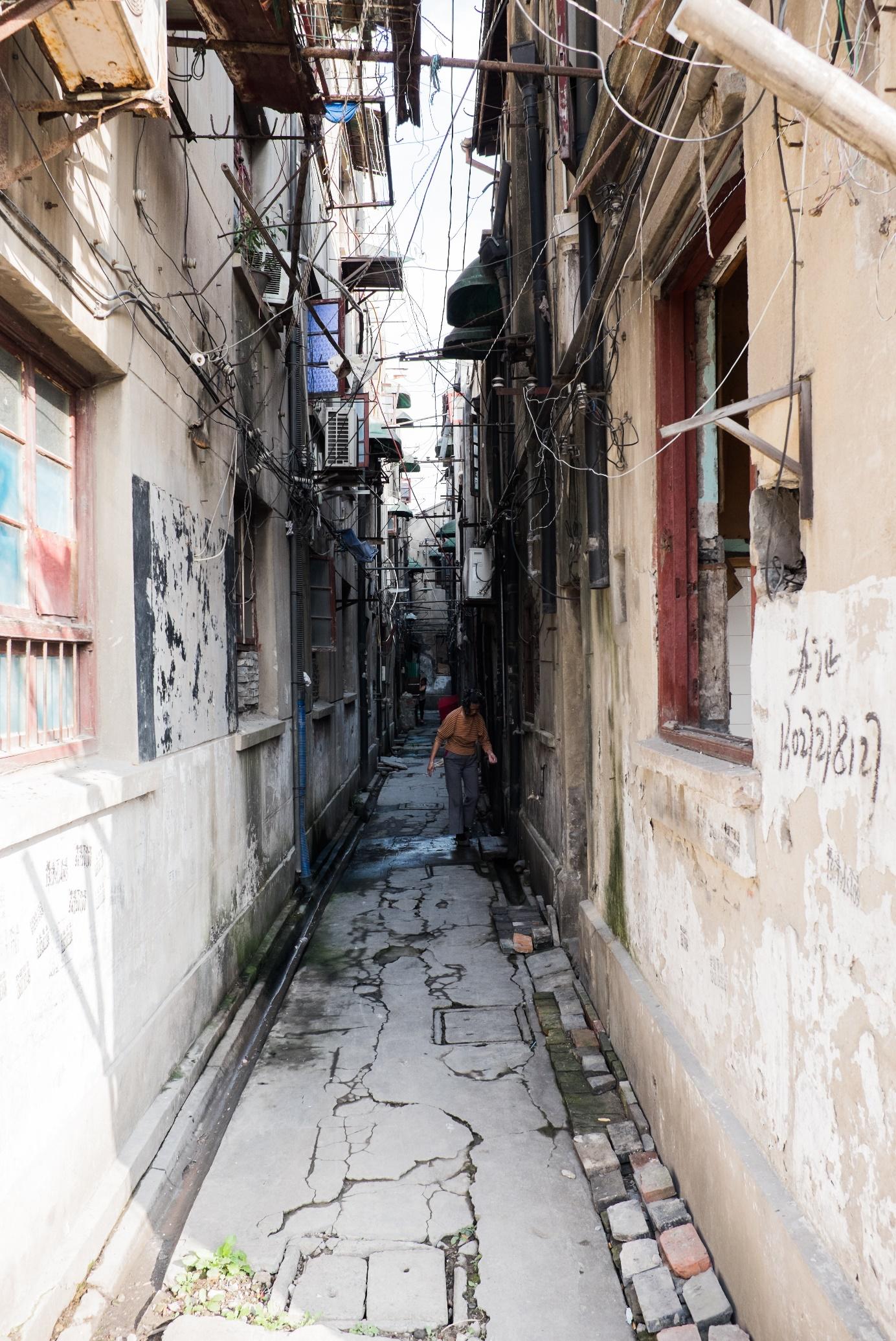 Lilong street view. image courtesy of the author.
Lilong street view. image courtesy of the author.
Lilong: a precious threatened typology
The urban pattern of Shanghai has been largely influenced by its colonial history. On 29th August 1842, the United Kingdom signed the Treaty of Nanjing with China, requiring the opening of the top five Chinese gates to foreign trade, including the city of Shanghai. The British, followed by the American and the French defined their own territory in the city (Bergère, 2002). The "Lilong", group of traditional houses connected by lanes, primarily for Chinese workers and employees, appeared quickly within the concessions and expanded. These adjoining townhouses were originally designed to be the most cost effective system to exploit ground surface. These townhouses are commonly known as the shikumen (石库门), which literally means «stone gate» (Bracken, 2013). This typology combines the English working-class homes with the fundamental principles of traditional Chinese houses, siheyuan (四合院) constructed of brick and wood.
The Lilong is organized like a fish skeleton, with the Shikumen opening onto the narrow streets of the skeletal ribs. This system is based on a combination of one or two main streets with narrow side streets leading to dead ends with houses.

The principle structure of Lilong. image source: Proletariat Unit
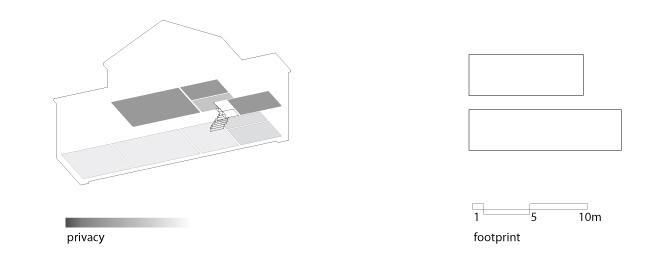
Illustration of longtang (弄堂). image source: Proletariat Unit
Outside the plot, these buildings form a continuous frontage pierced by stone portals that are the access point to the main streets of the lilong. The hierarchy of the network, called longtang (弄堂) is essential to establishing a gradation of intimacy. The dynamic sequence of space from the main Public Street to smaller semi-public lanes, to semi-private courtyards, and lastly to the heart of the house encourages social interactions and small business development. While street life is totally eliminated around high rises, these rich and vibrant streets can be compared as an ecosystem where all activities are provided. These villages are favorable to small-scale commercial development. Work and house are often linked together, almost merging in accordance with the meaning of 'jia' in Chinese that characterize the house, the family and the place generating wealth for the family. Unlike the new typology of block that invades the Chinese cities, communities are human-scaled, offering a special intimacy appropriate for dwelling and daily life. This feature facilitates social gathering, the foundation of a healthy civic sphere.
When the communist party came to power in 1949, the city grew according to the cold logic of industry and efficiency, and started to loose its warm and vibrant atmosphere. Traditional urban areas began to deteriorate. While one family was living in decent sanitary conditions, twelve were not (Zhang, 2009). Overcrowding caused degradation of the Lilong. In the 1950's, considering the state of the housing stock, the municipality decided to take control of the situation and clear these settlements, relocating their populations to newly constructed suburbs. Although some houses were slightly renovated, with the addition of bathrooms or additional floors, the problems of overcrowding and unsanitary conditions persist today.
In Europe, the importance of architectural heritage was recognized only after the French Revolution in 1789. Damaged landscapes angered some authors including Victor Hugo, outraged to see the deplorable state of French heritage. It is only from the end of 19th century that the concept of heritage has extended to the rest of the world. China's attitude toward material sustainability is completely different from the European (Zhang, 2003). While Ancient Egyptian construction aspired to immortality, there is no desire of preservation in China. Chinese people simply replace old with the new, and see life and death as a natural cycle. Thus, architecture in China is not associated with the idea of duration, and material is not made to last but to be renewed.
The traditional cores originally surrounding the city have been gradually assimilated in the city and are now traceable among the invasion of more recent housing blocks. The rush to triple the amount of living space per person in a city of 17 million people in addition to the need to accommodate migrants from rural areas induced a massive housing boom in Shanghai (Burdett & Sudijc, 2008). The city's landscape has therefore undergone a more dramatic spatial transformation than any other city. This massive build-up turned the fisherman's, and later colonial city made of traditional "Longtang", into a booming district filled with modern skyscrapers and factories. Architecture heritage has been destroyed and replaced by tons of concrete. Its development has been indeed mainly guided by economic constraints. These traditional houses located usually in the city centre are redeveloped due to land value, forcing inhabitants to relocate to suburban areas. Moreover, government supports this material and cultural destruction. During the 1990s, developers were awarded from $40 to $110 for every square meter demolished according to location and housing conditions (Xuefei, 2013). In the whole country a total of 1.5 million urban homes were demolished between 1992 and 1994 (Hui, 2013).
Nowadays, the authorities still focus only on profitability. Thus, Shanghai now looks like a new city; the showcase of the country's economic success. But the Lilongs, buildings that have forged and welded Shanghainese communities since the mid-ninteeth century, are an integral part of the identity of the city. Their future is increasingly threatened by the limited interest of investors and authorities. These buildings, the fabric of the old city, are seen as obsolete, unsanitary and overcrowded. Their existence undermines the desired image of progress. More than attempting to preserve architectural heritage in a frozen state, the question is how to integrate this cultural and social heritage in a way that creates added value to the evolution of the city.

Housing types (from 1950 to 1980). Source: Tongji university – Shanghai statistics - Zhongguotongjichubanshe
Urban strategy
"Learning from the existing landscape is a way of being revolutionary for an architect. Not the obvious way, which is to tear down Paris and begin again, as Le Corbusier suggested in the 1920s, but another more tolerant way; that is, to question how we look at things." - Denise Scott Brown, Robert Venturi, Steven Izenour
Preserving patches of traditional houses through the city would reinforce the iconic features of these patterns and maintain the unique social conditions and culture heritage. The juxtaposition of the old pattern with an innovative and adapted urban form responding to the current dencity needs would reinforce their respective status and qualities. To solve the undefined current urban structure of Shanghai, the city would be structured through multiple historical centers always at walking distance from each other. Rather than to excessively preserve or demolish, it would be judicious to encourage the object to be integrated in a new structure. As Richard Sennett states, it's a matter of evolution rather than renewal (Sennett, 2006). Thus the city would be structured through a dynamic sequence of spaces promoting diversity, dynamism and social activities for the pedestrian. It might be appropriate to reach a balanced situation where both typologies end up undefeated.
Why not lever a rich architectural heritage to create a hybridized urbanism that frames the aspirations of rapid development within the context of a dynamic and human scaled city? China must save its urban villages and learn from them. While focusing on the growth of wealth and high rises, urban development should pay attention to community stability, street life, and social services. Taking advantage of existing urban structure, dialoguing with the context, and integrating existing social structures is absolutely necessary in the renewal process.
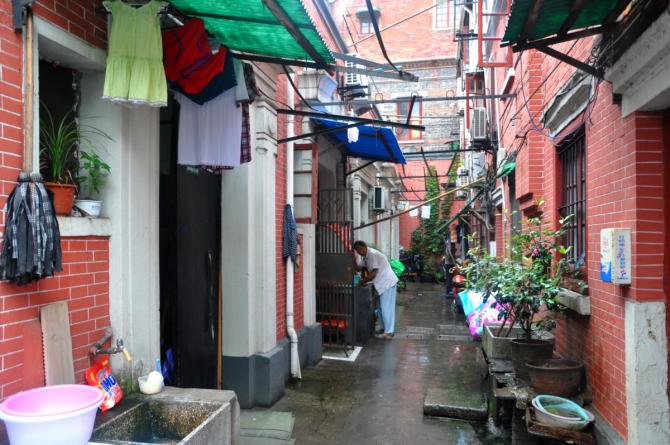
A man washes clothes off one of the side lanes of a Lilong development in the Luwan district of Shanghai.
image source: Proletariat Unit
A system
As in Le Corbusier's model for "Plan Voisin", public life at the ground level is eliminated due to the absence of the street, consequently forcing people to live and work in an isolated way (Rowe & Koetter, 1984). This strategy denies the evolution of the city and freezes the city in time. Growth needs a relationship with the past in order to make it evolve rather than destroy. At a time when both authorities and planners are ravaging slums and participating in the annihilation of local culture and heritage, even more diversity, density and dynamism should be considered as an urgent remedy to the dramatic situation. A crowded and complex environment where people and activities blend into a vivid, democratic and self-organized urban environment would benefit the Chinese population. Rather than developing usual architecture projects, one solution would be to consider the development of the city more as an anarchist system based on the participation of the population, in a similar way to the urban settlements. Because of the absence of planning, the system, composed by stacked small human scale entities, would be able to evolve continuously and adapt to the social and demographic needs.
The example of Tianzifang (田子坊), a traditional lilong disctict of Shanghai, demonstrates that communities are already developing and improving their neighborhoods without the agreement of the authorities. While the government was planning to tear down the district, residents with the help of artists began to redevelop the Shikumen without consulting the municipality. Today Tianzifang is a place combining specialized craft shops, designers and artists 's studios, offices, galleries, restaurants, and cafes. Visitors can discover a whole new world of the narrow lanes that unfold between the rehabilitated old shikumen. Although the streets are always crowded they release a serene atmosphere that enhances this authentic place.
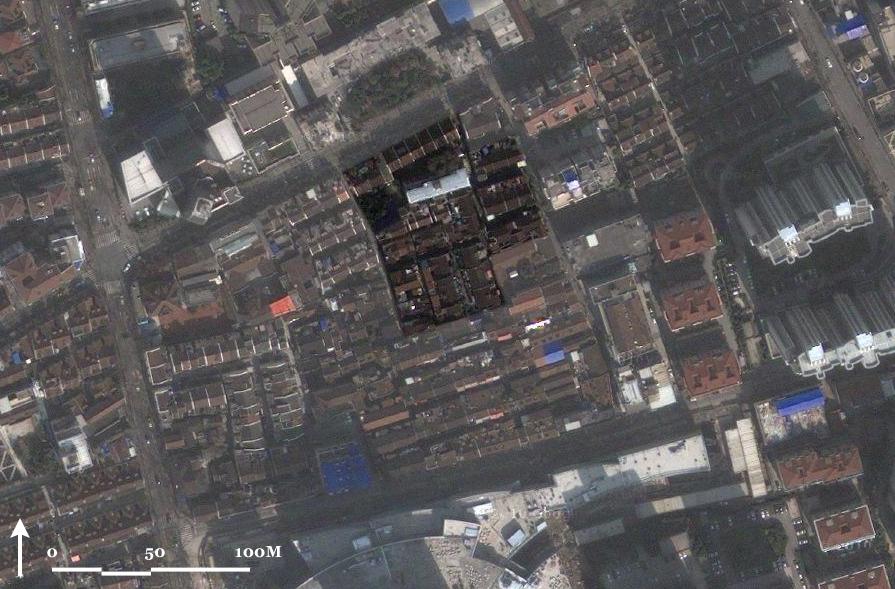
Satellite view of Tianzifang
Is social and economic diversity a utopia?
Due to the strongly linked community developed by this proposed system, the various neighbourhoods can grow into a strong economic entity while maintaining its living qualities. The introduction of various entities providing a diversity of housing typologies accommodates a large portion of the population, from the poor migrants to the successful businessman. In reaction to increasing social segregation, the project aims to include people from the lowest to the highest social classes. By bringing wealthier inhabitants to poor districts without relocating the original inhabitants, low-income communities will benefit from social diversity and start to recover. The main challenge in this process is to preserve the original community while attracting wealthier population.
Furthermore, the usual high rise, demanding considerable investment, is often linked to the global economic system and foreign investments, avoiding investment from people with a lower budget. By considering the development of the city not as massive entities but as evolving, adaptable and flexible structures, investments become accessible to a larger portion of the population.
Conclusion
Shanghai is one of the largest construction sites in the world, where profitability, speculation and destruction are the key words. New towers, growing higher and higher, continue to add a modern touch to the urban panorama, while imposing on traditional urban fabric, mainly composed of Lilong. Thus, over the past two decades, the urban development of Shanghai shows that efforts to preserve the existing city have been unsuccessful. By neglecting cultural heritage, don't we risk depriving contemporary and future populations of their identity?
Innovative economic, social, urban, and architectural solutions are urgently needed. Rather than demolishing traditional building stock and relocating existing urban communities, priority should be given to the improvement of infrastructure in traditional areas.
Self-organized cities involving local populations is a solution that absolutely needs to be explored further.
{About the author}
Originally from Belgium, Nicolas graduated with a bachelor degree in architecture from the Faculty of Architecture La Cambre Horta in Brussels, Belgium, and with a master degree in architecture from the Oulu School of Architecture in Oulu, Finland were he prepared his master thesis "From Urban Village to Density". He gave two conferences on that topic at the University in Oulu in 2014 and in Antwerp for the real estate congress 2014. Besides studying he worked at David Chipperfield Architects in Shanghai, at Sou Foujimoto Architects in Tokyo and now at BIG in New York city.
{Bibliography}
Bergère, M.-C., 2002. Histoire de Shanghai. Fayard.
Bracken, G., 2013. The Shanghai Alleyway House: A threatened Typology. Footprint, p.45.
Burdett, R. & Sudijc, D., eds., 2008. The Endless City. Phaidon Press Inc.
Hui, X., 2013. Housing, Urban Renewal and Socio-Spatial Integration: A Study on Rehabilitating the Former Socialistic Public Housing Areas in Beijing. 1st ed. Delft: TU Delft.
Rowe, C. & Koetter, F., 1984. Collage city. Cambridge: MIT Press.
Sennett, R., 2006. The Open City: Housing and Urban Neighbourhoods. Urban Age.
Venturi , R., Brown, D.S. & Izenour, S., 1977. Learning from Las Vegas. Cambridge: The MIT Press.
Xuefei, R., 2013. Urban China. Cambridge: Polity Press.
Zhang, L., 2003. La Naissance du concept de patrimoine en Chine. Paris: Ipraus.
Zhang, L., 2009. Reform of the Hukou System and Rural-Urban Migration in China: the Challenges Ahead. Download document